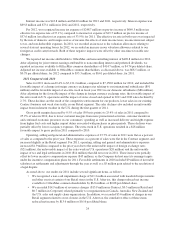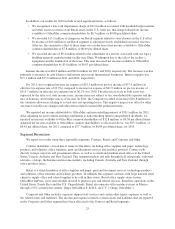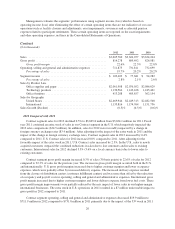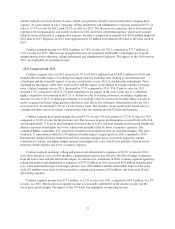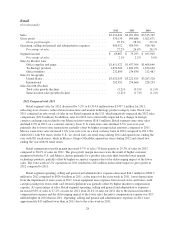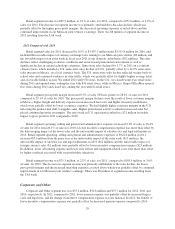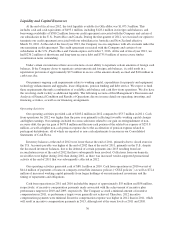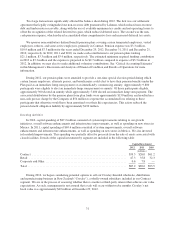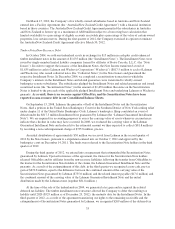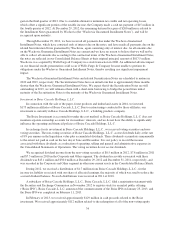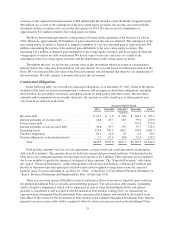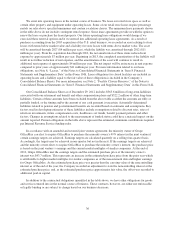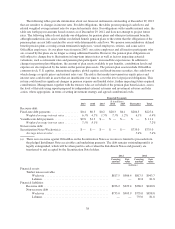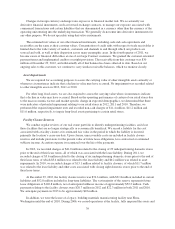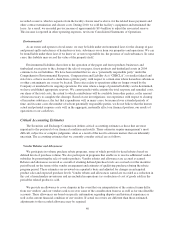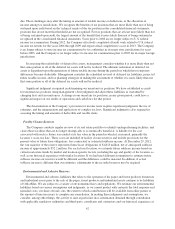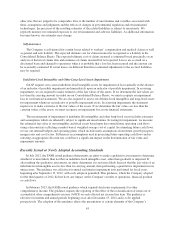OfficeMax 2012 Annual Report Download - page 69
Download and view the complete annual report
Please find page 69 of the 2012 OfficeMax annual report below. You can navigate through the pages in the report by either clicking on the pages listed below, or by using the keyword search tool below to find specific information within the annual report.On March 15, 2010, the Company’s five wholly-owned subsidiaries based in Australia and New Zealand
entered into a Facility Agreement (the “Australia/New Zealand Credit Agreement”) with a financial institution
based in those countries. The Australia/New Zealand Credit Agreement permitted the subsidiaries in Australia
and New Zealand to borrow up to a maximum of A$80 million subject to a borrowing base calculation that
limited availability to a percentage of eligible accounts receivable plus a percentage of the value of certain owned
properties, less certain reserves. During the first quarter of 2012, the Company exercised its option to terminate
the Australia/New Zealand Credit Agreement effective March 30, 2012.
Timber Notes/Non-Recourse Debt
In October 2004, we sold our timberland assets in exchange for $15 million in cash plus credit-enhanced
timber installment notes in the amount of $1,635 million (the “Installment Notes”). The Installment Notes were
issued by single-member limited liability companies formed by affiliates of Boise Cascade, L.L.C. (the “Note
Issuers”). In order to support the issuance of the Installment Notes, the Note Issuers transferred a total of
$1,635 million in cash to Lehman and Wachovia Corporation (“Wachovia”) ($817.5 million to each of Lehman
and Wachovia) who issued collateral notes (the “Collateral Notes”) to the Note Issuers and guaranteed the
respective Installment Notes. In December 2004, we completed a securitization transaction in which the
Company’s interests in the Installment Notes and related guarantees were transferred to wholly-owned
bankruptcy remote subsidiaries. The subsidiaries pledged the Installment Notes and related guarantees and issued
securitized notes (the “Securitization Notes”) in the amount of $1,470 million. Recourse on the Securitization
Notes is limited to the proceeds of the applicable pledged Installment Notes and underlying Lehman or Wachovia
guaranty. As a result, there is no recourse against OfficeMax, and the Securitization Notes have been
reported as non-recourse debt in our Consolidated Balance Sheets.
On September 15, 2008, Lehman, the guarantor of half of the Installment Notes and the Securitization
Notes, filed a petition in the United States Bankruptcy Court for the Southern District of New York seeking relief
under chapter 11 of the United States Bankruptcy Code. Lehman’s bankruptcy filing constituted an event of
default under the $817.5 million Installment Note guaranteed by Lehman (the “Lehman Guaranteed Installment
Note”). We are required for accounting purposes to assess the carrying value of assets whenever circumstances
indicate that a decline in value may have occurred. In 2008, we evaluated the carrying value of the Lehman
Guaranteed Installment Note and reduced it to the estimated amount we then expected to collect ($81.8 million)
by recording a non-cash impairment charge of $735.8 million, pre-tax.
An initial distribution of approximately $50 million was received from Lehman in the second quarter of
2012 by the Note Issuers, pursuant to a stipulation entered into on October 7, 2011 and approved by the
bankruptcy court on December 14, 2011. The funds were released to the Securitization Note holders in the third
quarter of 2012.
During the third quarter of 2012, we entered into an agreement that extinguished the Securitization Notes
guaranteed by Lehman. Upon effectiveness of the agreement, the trustee for the Securitization Note holders
released OfficeMax and its affiliates from the non-recourse liabilities following the transfer from OfficeMax to
the trustee for the Securitization Note holders of the claims, the Lehman Guaranteed Installment Note and the
guaranty. As a result of the extinguishment of this debt, in the third quarter we recognized a non-cash, pre-tax
gain of $670.8 million, equal to the difference between the combined amount of the carrying value of the
Securitization Notes guaranteed by Lehman ($735.0 million) and the related interest payable ($17.6 million) and
the combined amount of the carrying value of the Lehman Guaranteed Installment Note and the initial
distribution made by the Lehman estate (together $81.8 million.)
At the time of the sale of the timberlands in 2004, we generated a tax gain and recognized the related
deferred tax liability. The timber installment notes structure allowed the Company to defer the resulting tax
liability until 2020 ($529 million as of December 29, 2012), the maturity date for the Installment Notes. In the
third quarter of 2012, as a result of the agreement transferring our rights to the remaining receivable and the
extinguishment of Securitization Notes guaranteed by Lehman, we recognized $269 million of the deferred tax
33



